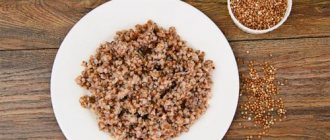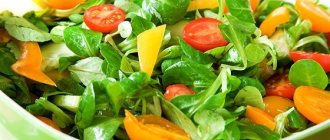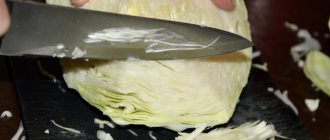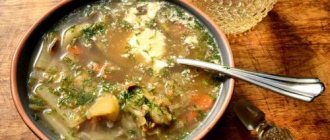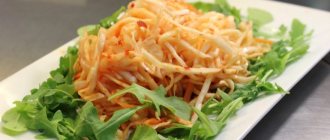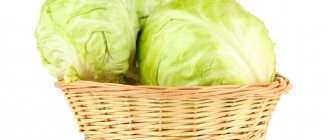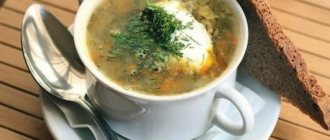When switching to dietary nutrition, you must be guided by the principle “do no harm”! Excluding some foods from the daily diet leads not only to a decrease in the total calorie content of one meal, but also to a decrease in the consumption of vitamins and microelements necessary for the body.
The resulting deficiency of useful components must be compensated. Therefore, active consumption of vegetables (within the calories allocated for the day) is strongly recommended by doctors, nutritionists and fitness trainers. One of the easy-to-prepare and low-calorie vegetable dishes is stewed cabbage.
Stewed cabbage in a healthy diet
Properly cooked cabbage is considered an ideal part of a diet menu. 100 g of product contains 30% of the daily value of vitamin C.
In addition, the vegetable is low-calorie: 100 g contains 5-6 g of carbohydrates, 1.5-2 g of proteins and 2 g of fat. In their raw form, the nutritional value of cabbage leaves is only 20-25 kcal.
The dish has a beneficial effect on the cardiovascular system, gastrointestinal tract, and immunity:
- lowers blood pressure, dilates blood vessels, prevents cholesterol accumulation, accelerates blood flow;
- improves metabolism, promotes the proliferation of beneficial bacteria, cleanses the blood of toxins, removes uric acid;
- strengthens the skeleton (cartilage and bone tissue), prevents the development of osteoporosis;
- iodine and vitamin A help improve vision, saturate the brain with useful substances, and normal functioning of the nervous and endocrine systems;
- helps in the fight against depression, Alzheimer's disease;
- prevents the growth of cancer cells, fights inflammatory processes.
Is the dish good for a diet?
The key advantage of cabbage is the combination of reduced calorie content and a whole range of vitamins, antioxidants and microelements in its composition. The vegetable contains:
- potassium;
- calcium;
- phosphorus;
- manganese;
- iodine;
- ascorbic acid;
- vitamin D and all group B;
- tocopherol
The complex of nutrients has a positive effect on the immune system and metabolic processes in the body, strengthens the cardiovascular and nervous system, and helps build a healthy and fit body. When consumed regularly, cabbage lowers cholesterol levels in the blood, normalizes blood pressure, and reduces the number of allergic reactions and skin rashes.
Note! Plant fibers help stewed cabbage to quickly saturate the body, satisfy hunger, and promote its natural cleansing. They are also aimed at quickly breaking down carbohydrates, which are often the cause of excess weight.
A cabbage dish requires a significant amount of energy to be processed in the gastrointestinal tract.
Be sure to check out: Diet cabbage salad: the best recipes Safe cleansing: flax seeds for weight loss Kefir on a diet: are alternatives possible Proper castling: how to replace high-calorie treats and allergenic foods on a diet
Ingredients and calorie content of the recipe “Stewed cabbage”
Depending on the components of the dish, its calorie content changes. The cooking process also affects the nutritional and energy value of the finished product.
Steaming with the lid closed preserves all the beneficial substances in the cabbage, and frying over an open fire reduces the mineral content.
| Ingredient | Calorie content per 100 grams (kcal) |
| White cabbage | 25 |
| Red cabbage | 31 |
| Carrot | 32 |
| Onion | 40 |
| Pork | 242-300 |
| Beef | 245-260 |
| Chicken (no skin) | 170-214 |
| Mushrooms (oyster mushrooms) | 38 |
| Champignon mushrooms) | 27 |
| Homemade tomato | 20-40 |
| Tomatoes | 20 |
| Tomato paste | 80-85 |
| Sunflower oil | 884 |
| Olive oil | 880 |
Be sure to read: How many calories are in 100 grams of cauliflower, beneficial properties and contraindications of the product
When stewed, products retain their calorie content, but lose microelements. Steaming allows you to reduce the energy value by 3-5%, but leave minerals and vitamins in vegetables. Calorie content increases significantly with prolonged frying.
A standard dish with the addition of vegetable oil, carrots and tomato paste contains 40-60 kilocalories per 100 g. If the composition includes chicken, then the nutritional value increases to 100-150 kcal, with meat - from 200 kcal, with mushrooms - 130-140 kcal.
Nutritional value of white cabbage
White cabbage is a source of many vitamins and minerals. It not only helps to reduce excess weight during diets, but also saturates the body with microelements. The secret of these properties lies in the chemical composition of the product, including white cabbage is saturated with the following beneficial substances:
- Iodine;
- Magnesium;
- Sodium;
- Manganese;
- Phosphorus;
- Vitamins of groups A, B, C, E, H.
The content of macro and microelements, as you can see, is at a very high level, while the amount of fat and calories in the vegetable is extremely low, both raw and cooked. Energy value of white cabbage:
- 2 grams or 10% of the daily value of dietary fiber;
- 90.5 grams of water or 3.53% of the daily value;
- 3.67% carbohydrates;
- 0.31% fat;
- 2.2% proteins.
Stewed cabbage recipes
The product is popular in many countries (India, Germany, Russia, Ukraine, Britain, Japan). Each country has special recipes and additives.
To ensure that the vegetable does not lose its beneficial properties, it is processed briefly until it has a golden color and soft texture. Cooking does not require special culinary skills or a lot of time.
The dish is prepared on the stove (frying pan, in a casserole dish, in a stewpan), in a double boiler or slow cooker, and baked in the oven. At the same time, the taste of the finished product changes.
A mixture of peppers, bay leaves, citric acid, turmeric, garlic, cardamom, cumin, cloves, nutmeg, and ginger are used as spices.
Stewed cabbage with tomato - classic recipe
Stewed cabbage with tomatoes is prepared in a frying pan or in a slow cooker. The preparation option is suitable for diet, fasting, and recovery from illness. The number of calories in the finished dish is 60 kcal per 100 g.
Ingredients:
- onion – 1 pc.;
- carrots – 200-250 g;
- head of cabbage – 1 pc.;
- tomato paste – 1 triangle or single package, can be replaced with fresh tomatoes or canned juice;
- salt, pepper - to taste;
- vegetable oil - for frying.
Preparation:
- Heat the frying pan and add one tablespoon of oil.
- Coarsely chop the onion, fry it for 2-3 minutes, add grated carrots.
- After 10 minutes, add shredded cabbage and simmer, covered, until golden brown so that all the liquid has evaporated. At this stage, add spices, bay leaves, tomato paste, and salt to taste.
- The dish is thoroughly kneaded and fried without a lid until cooked (soft texture and reddish-orange color).
Be sure to read: Benefits of seaweed, calorie content per 100 grams, cooking methods
Cabbage stewed in apple juice
Cabbage stewed in apple juice
The recipe is useful because there is no oil; instead, apple juice is used, which has a positive effect on digestion. Nutritional value – 80 kcal per 100 g.
You will need:
- apple juice – 1 glass;
- red cabbage – 500-700 g;
- apples – 2 pcs.;
- carrots – 1 pc.;
- vinegar – 1 tsp;
- cloves, salt, pepper - to taste.
Preparation:
- In a saucepan, heat the juice to a boil, add spices and vinegar.
- Shred the cabbage and add it to the pan.
- The mixture is simmered until golden brown; sugar is used to obtain a sweetish taste.
- The finished dish is decorated with fresh sweet and sour apples and carrots, you can add raisins and walnuts.
Cabbage stewed with carrots and onions
Stewed cabbage with carrots and onions
The recipe is good for a slow cooker or double boiler. The same ingredients are used as for the classic version of the dish.
Preparation:
- Vegetables are chopped and mixed, spices and tomato paste diluted with boiled water are added (1 tbsp per 1 glass of liquid).
- The resulting raw salad is sent to the multicooker for the “Frying” or “Stewing” program. Season with herbs for taste.
Stewed cabbage with meat
Stewed cabbage with meat
The most high-calorie option (140-250 kcal), suitable as a main dish. You can use any meat (pork, beef, lamb, rabbit).
Chicken has the least fat, so only chicken breasts and drumsticks are allowed in the diet menu.
Will need:
- chicken fillet – 500 g;
- white cabbage – 800-900 g;
- carrots – 1 pc.;
- onion – 1 pc.;
- tomato juice – single packaging;
- spices, salt - to taste;
- vegetable oil - for frying.
Preparation:
- Chicken breast or fillet is cut into cubes, fried until cooked, and placed in a container.
- Onions and carrots are fried in the same frying pan, and shredded cabbage salad with tomato juice and spices is added.
- Under a closed lid, simmer until done, add to the cooked meat and serve.
Be sure to read: Calorie content of cabbage rolls with chicken, pork, minced beef in cabbage or lazy
To reduce calories, you can change the frying method. Pieces of fillet are laid out in a duck dish or ceramic form. A mixture of cabbage, onions and carrots is poured on top.
The mold is filled with tomato juice, covered with foil and placed in the oven for 30-50 minutes.
Is the dish considered dietary?
Cabbage contains approximately 27 kcal per 100 grams, which makes it popular in the diet menu. Other benefits for people losing weight:
- a large amount of vitamins that are not destroyed by gentle heat treatment;
- reduced glycemic index, providing a long-lasting feeling of fullness;
- a large portion of plant fiber, which gently cleanses the intestines and activates the natural process of weight loss;
- stewing makes cabbage as easy as possible to digest.
A diet based on stewed cabbage has become very popular. It only costs one dish, so you can sit on it for no more than 3 days in a row. Due to strict restrictions, it is easy to lose about 3-4 kg with such a menu.
The harm of stewed cabbage
A person needs no more than 200-250 g of this dish per day. Stewed cabbage is prohibited for people with ulcers and people suffering from diabetes, kidney problems, and intestinal diseases.
In excess of the norm, the product:
- causes diarrhea, bloating (fiber contained in cabbage leaves helps speed up the digestion and decomposition of food);
- provokes blood thickening;
- affects the production of thyroid hormones (during decomposition, ions are released that block iodine, which can lead to the development of hypothyroidism).
Characteristics of white cabbage: glycemic index
White cabbage is indispensable in the world of diets. A balanced diet requires calculating several indicators, including the glycemic index.
Glycemic index - consists of a numerical scale from 0 to 100. Each consumed product can be measured using the index, it allows you to understand the amount of carbohydrates in food, as well as the speed of their elimination from the body. The higher the glycemic index scale, the worse the food you eat will affect your figure. If the number is minimal, then the product has a high content of fiber and complex carbohydrates.
In white cabbage, this indicator is 15, which means it takes a long time to digest and does not increase blood sugar levels. The glycemic index does not change depending on the type of preparation of cabbage, so during a diet it can be consumed in any form.
Types of fiber
Dietary fiber can be soluble or insoluble. Both species are present in all plant foods, but in different proportions.
Soluble fiber, when in contact with liquid in the gastrointestinal tract, forms a gel-like substance that is easily digested by bacteria in the large intestine. Insoluble fiber makes waste products soft, so that food moves easily through the gastrointestinal tract without injuring or overloading it.
Benefits of soluble dietary fiber:
• Reduce total cholesterol and low-density lipoprotein levels - “bad” cholesterol, which clogs blood vessels; • Maintain normal blood sugar levels.
Benefits of insoluble dietary fiber:
• Normalize intestinal function; • Prevent constipation and gastrointestinal disorders; • Accelerate the removal of toxic waste through the colon; • Control the PH level in the intestines.
Consequences of fiber deficiency
• Constipation - makes the natural physiological process painful and uncomfortable. Dietary fiber helps avoid the development of congestion in the colon; • Excess weight - lack of dietary fiber prevents the body from controlling appetite. Fiber normalizes the speed of digestion and ensures a feeling of fullness for a long time.
Daily value of dietary fiber
Soluble and insoluble fiber should be consumed in a ratio of 25 and 75%. The daily norm is calculated depending on gender and age:
• Men under 50 years old – 38 grams; • Women under 50 years old – 25 grams; • Men over 50 years old – 30 grams; • Women over 50 years old – 21 grams.
However, you should not overuse plant fibers - this is not good for the body. An excess of fiber removes waste products faster, which is why the body does not receive enough nutrients and microelements. This leads to the following problems:
• Acute gastritis; • Bloating; • Diarrhea, irritable bowel syndrome; • Colic.
Calorie content and nutritional value per 100 grams of cabbage stewed with oil, without oil, with onions and carrots, with chicken
100 g of the finished dish contains about 40-55 calories. When adding additional foods or seasonings, the total calorie content increases:
| Dishes with stewed cabbage | Kcal | Proteins (g) | Fat (g) | Carbohydrates (g) |
| No oil | 40.2 | 1.7 | 0.2 | 9.5 |
| With butter | 46.9 | 1.8 | 2.1 | |
| With onions and carrots | 49.5 | 1.6 | 2.4 | 5.4 |
| With Chiken | 61 | 7.8 | 1.3 | 4.8 |
What white cabbage contains: calcium and fiber
It has been said more than once that white cabbage is valued for its low calorie and carbohydrate content, and is also rich in calcium and fiber.
Why does the body need calcium? Calcium helps strengthen bones and maintain healthy teeth. In addition, it controls intracellular processes, is responsible for muscle contractility, strengthens the immune system, and helps in digestion and metabolism.
Fiber is another essential component that helps keep the body functioning properly. The high content of coarse fiber in food helps cleanse the stomach of waste and toxins. Foods high in fiber are recommended to be consumed during a diet because they suppress appetite and provide the body with sufficient energy by breaking down slowly.
White cabbage contains 48 mg of calcium, which is 4.8% of the daily value. Of course, it is impossible to consider the product as the main source of calcium.
As for dietary fiber, white cabbage contains 2 g of it in a 100-gram serving (10% of the daily value). This is a very good indicator, considering that the vegetable is well digestible and has low calorie content.
Thus, white cabbage is a product that must be included not only in the dietary, but also in the regular diet.
It has a number of advantages:
- Contains microelements and vitamins that improve the health of the body;
- Increases skin tone and gives it beauty;
- Cleanses the body of toxins and other harmful substances;
- Improves blood circulation;
- It is a low-calorie food with optimal nutritional content;
- Promotes weight loss due to its high fiber content and complex carbohydrates.
Recommended by many nutritionists, white cabbage dishes will be an excellent addition to your everyday and holiday table.
Reading time: 4 minutes
Stewed cabbage is a dish rich in vitamins and minerals. The calorie content of a cabbage dish depends on the recipe (with meat, potatoes, tomato paste) and the type of product (cauliflower or white cabbage). Due to its composition, the dish has numerous beneficial properties for the body. In addition, the product is low in calories and helps you lose extra pounds. Stewed cabbage has a number of contraindications for consumption, which you should familiarize yourself with before consuming it.
Carbohydrates in white cabbage for weight loss
Many nutritionists from all over the world agreed that white cabbage is the best way to combat excess weight, since it is absorbed by the body very slowly. The main thing that all dieters pay attention to is the number of calories contained in the product. There are two types of calories - simple and complex.
It should be remembered that not all carbohydrates are harmful to the body. They make the body work, give the body energy for mental and physical actions. For this reason, it is impossible to maintain a completely carbohydrate-free diet.
It is important to determine the type of carbohydrate contained in a food product. Simple carbohydrates are found in many fruits, flour and sweets. They are not recommended for use during a diet, because... are very quickly eliminated from the body, again arousing the feeling of hunger due to lack of energy. Complex carbohydrates, on the contrary, take a long time to digest, satisfy the appetite for a long time and are used up, do not form fat folds.
In white cabbage, as in any other cabbage, the carbohydrate level is low and is only 6.8. The vegetable contains complex carbohydrates, which is why doctors recommend consuming the product while losing excess weight.
